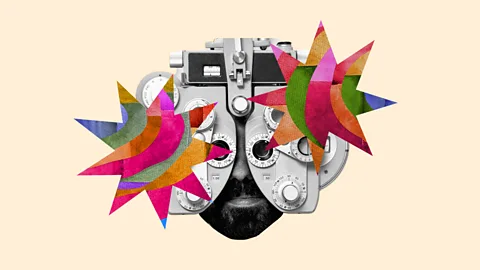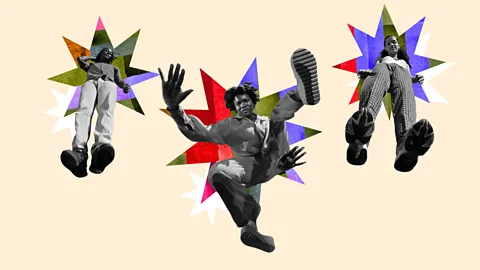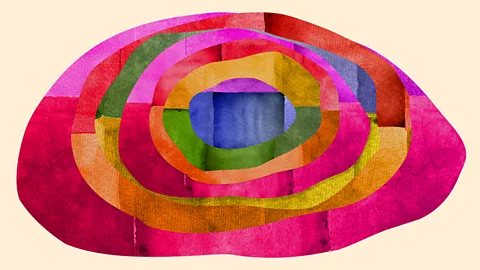 Serenity Strull/ BBC/ Getty Images
Serenity Strull/ BBC/ Getty ImagesSynesthesia is a neurological condition found to increase memory and learning. Now, scientists say that looking in color can help when it comes to learning a second language.
like many sinnaesttesI discovered at a young age that I had a gift for both music and language. In music, it was not the physical act of interpretation that I excelled, but composition. I continued to become a composer for short movies and dancing theaterand a sound editor for television. Writing music was very much like a language for me, as I “saw” the colors of sounds in a similar way. I have also studied French, German, Spanish and linguistics – the color of the language helping me remember the words as well as the patterns of grammar.
“When I was younger I knew I saw the world in a different way, and my way to describe it for others was’ colorful,” says Smadar Frisch.
Frisch, who has Syneestese with the color of graph, Syneestezi with sound colors AND lexical -besnator Sinnaesthesia – where words taste – explores the world of senses through its podcast, ChromaticAnd she is currently writing her first book on the subject. “Learning at school was a lot to me wisely,” she says. “It is very difficult to try to solve an equation when the whole coloring of a series of numbers was a psychhedral explosion.”
This color explosion, Frisch says, would make her lose focus and forget what she was doing. “[It was the] The same as the language. The words ‘the colors, the music and the feelings of the taste lit up me and I wanted to express myself so much – I lost the focus’.
 Serenity Strull/ BBC/ Getty Images
Serenity Strull/ BBC/ Getty ImagesThis was not until she almost finished high school she encountered in the book of Dmitri Nabokov, Wednesday is Indigo Blue. “My original opinion was that Wednesday is actually orange – and I needed to get this book.” That was a turning point for Frisch. “I finally realized how my brain of Sinaesthet is connected and wire -bound. And I thought to myself, this phenomenon is amazing. I can use colors to help me learn, rather than confuse me. “
Frisch developed a color coding system to help him learn new fluent and quickly languages. The study of languages no longer felt confusing but “organized,” she says. “And it worked! My whole world changed. I kept learning what my brain was meant to shine: Languages.”
Frisch says she was able to teach French and Spanish fluently in just two months. “I scored 90+ in each [French and Spanish] The exam, “she says. Today Frisch can speak seven languages fluently – and says she can learn any language she wants” without difficulty, in a short time. “
Julia Simner is the director of Multisisense Synaesthesia research Laboratory at the University of Sussex in the UK. She and her team tested about 6,000 children who were six to 10 years old. “We displayed each individually for Sinaestezi, and then we gave [them] a test battery to determine What skills come with Sinaestezi“She says.
The study found that children with sinnaesthesia were better in a number of skills than children without – skills which, according to Simner, would certainly help both teaching the first and second language. “
“Specifically, they were significantly better in the host vocabulary (how many words they could understand), the manufacturing vocabulary (how many words they knew), short -term memory store, attention to details and creativity,” Simner says. “These sincerity -related skills predict that we can expect to learn in the second language to be easier for someone with Sinaestez.”
Having sinnaesthetic colors, she says, makes the letters more memorable. And the colors of Sinaestese can pass from a language to the second language learned, making the words in the second language even more memorable. “The way these colors penetrate the tongue can happen either by the way the letter or the way the letter sounds like,” Simner says. “Likes like color scaffolding from one language to another.”
In 2019, another experiment led by psychologists at the University of Toronto, Canada, found graphic synaestez, where each letter and number has its own color, provides a significant advantage in statistical learning – Allowing a person to “see” patterns – a critical language learning ability.
Researchers asked participants to hear a series of nonsense-for example words, “Muh-Kah” and “BiH-OD”-representing an artificial “language”.
They then heard a second group of words. This group included original artificial words, plus new artificial words representing a “foreign” language. Participants were then asked to distinguish “words” from each of the two artificial languages.
“It didn’t make sense,” says Amy Finn, psychologist and director of cognitive neuroscience and development of the University of Toronto, Development Laboratory, Finn land laboratory. “Was built to see the” segmentation ” – or how use the regularities to derive what language segments are. This is a very early but super -important problem in early language learning.”
Results showed that the color graphic sinnaesttes were better able to distinguish between two “languages” than participants who did not have sinnaesthesia. “We think [synaesthesia] It can help you analyze the tongue pieces more easily, ”Fin says.
When the sinnaesthet experience the same models with more than one meaning – for example, both aurally and visually – their mind creates a secondary bonus suggestion that can help them recognize or remember the model.
 Serenity Strull/ BBC/ Getty Images
Serenity Strull/ BBC/ Getty ImagesTake the 11-year-old me, come in place in my first high school week. “How do you say” work “?” Seeks my French teacher. The class is silent. I know the word is blue. Then I come to me. “Travail”, I answer. Sometimes I don’t remember a word – but I can remember the color. This can be disappointing because no one can help me if I say “it’s pink” as the colors are unique to my mind. On the other hand, color acts as an additional memory, a bonus suggestion I can use when learning language.
You can, therefore, think that Sinaestez would be more widespread in bilingual children. But research suggests that people that Learn a second language later than early childhood are more likely to have this sensory ability of change than those who are bilingual bilingual. This strengthens the theory that synaesthesia develops as a teaching tool.
SINO appears in childhoodAs a child begins to get into the world around them, and they learn to speak, read and write. A 2016 study by researchers in Canada, SH.BA and Republika Czecheke found that children learn to categorize colors between the ages of four and seven, about the time they begin to learn and write, and Synaesthesia then begins to go out of the age of six. The study authors assume: “Children use their newly acquired ability to categorize color as a iododic aid in mastering the letters and words.”
However, sinnaesthesia can occasionally make communication more difficult – and the suggestion that synnaesthesia can function as a strategy to facilitate learning “remains a topic of debate,” says Lucie Bouvet, a psychologist at the University of Toulouse, France.
“Sinaestezia with Phoneme Color [is where] All phonemes – the smallest unit of spoken meaning – evokes the perception of specific colors, “says bouvet. This is the experience of a woman identified as ‘va’ in A letter of 2023 co -author from Bouvet. For example, whenever Va hears a strong “a” sound, she sees bright cyan. Whenever you hear “k”, you see red.
“VA describes a way of thinking in images, where words function as a second language,” says Bouvet. “The colors evoked by the phonemes help him to enter the meaning.” The VA communication process is to listen to the sounds, then see the colors, then translate the meaning from those colors.
This double translation attempt can make VA lose conversations. “In rare cases, individuals can find their overwhelming synaestes, feeling that their inner experiences interfere with their perception of the outside world,” Bouvet explains.
Whether useful or not for Sinaesthete, research for Sinaesteesi can help us Understand cognitive processes of language and perception. “Synaesthesia is an intriguing phenomenon in itself,” says Bouvet. “But the latest research suggests that it is part of a wider, specific cognitive profile. Identifying this unique cognitive profile can be essential to gain a deeper understanding of Sinaestese.”
For me, living life with a sense of feeling brings joy. Listening to music is a completely diving experience. I dip in an ocean of the structure, as if I were under a soft duvet or immersed in fresh water. The words of a book are not just inert paint on one page, but bring the story to life as they rotate around me. And the tongue fills the air in a color kaleidoscope.
For more science, technology, environment and health stories from the BBC, follow us Facebook, X AND Instagram.
